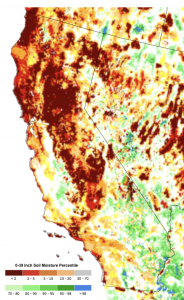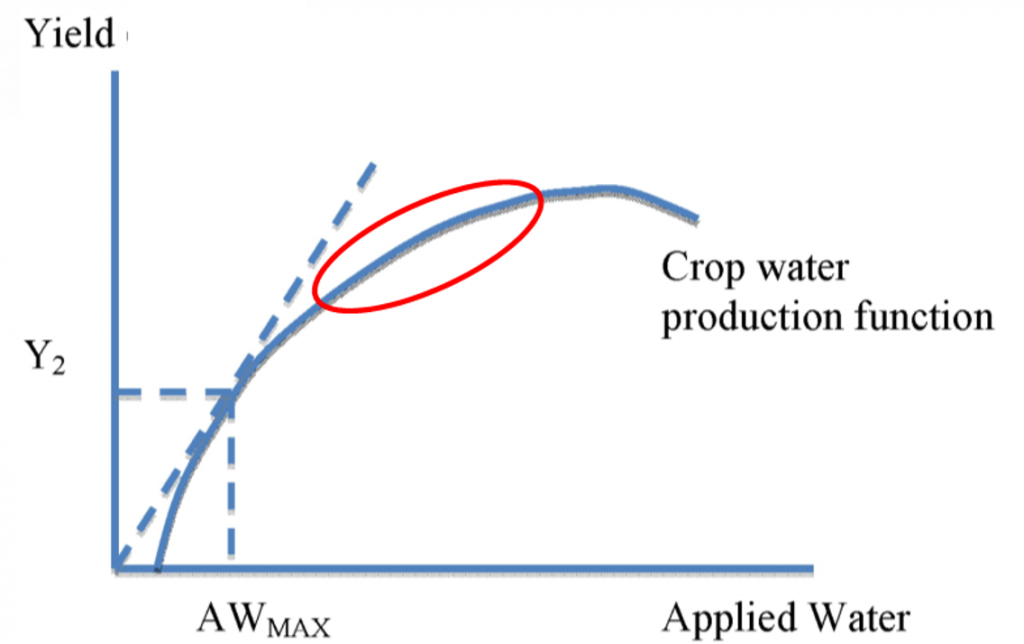Mallika Nocco, CE Specialist, Soil-Plant-Water Relations and Irrigation Management, UC Davis
As of May 12, 2021, a drought emergency has been declared for 41 CA counties. The deep integrated soil moisture profile between 0-39” is considered a strong drought indicator and is below the second percentile in much of the Sacramento Valley (Figure 1). Many growers and water managers are already making difficult decisions such as fallowing annual crops to allocate water for perennials, purchasing water transfers, or delaying new plantings. This blog’s purpose is to share several University of California drought resources that have been created and vetted to support growers during this challenging year.

Figure 1. High-resolution 0-39” soil moisture percentile from NASA’s Short-term Prediction and Transition Center – Land Information System (SPoRT-LIS). Retrieved May 12, 2021 by Mallika Nocco.
Drought Tip Fact Sheets are peer-reviewed resources developed by the University of California Agriculture and Natural Resources with support from the California Department of Water Resources. Most of these fact sheets were created during the 2014-2017 drought years. Drought tips are organized by crop type with specific fact sheets for almond, prune, walnut, and olive production. Though specific recommendations differ by crop, some form of regulated deficit irrigation is recommended to weather drought in almond, prune, walnut, and olives.
Regulated deficit irrigation is a strategy that can be used to maximize yields and profits as water becomes scarce and expensive. The strategy is to leverage the portion of the crop water production function (Figure 2) where increasing applied water no longer results in commensurate yield or profit gains (Figure 2, red oval). Regulated deficit irrigation can also improve crop quality, disease management, and harvest management in many cases.

Figure 2. Hypothetical crop water production function modified from Wilchens, 2014. The red oval region indicates the opportunity for regulated deficit irrigation.
Prior to engaging in regulated deficit irrigation, it is strongly recommended to ensure that your irrigation systems have high distribution uniformity and optimal application efficiency. Low distribution uniformity will result in poorly regulated deficit irrigation across an orchard. Learn more at UC ANR’s maintenance of microirrigation systems site. An older but still valuable resource also summarizes individual crop irrigation information for a variety of crops including almond, walnut, and olives.
You will find that in most cases, careful monitoring of both ET and stem water potential are critical for regulated deficit irrigation and drought management. Crop specific weekly ET totals can be found on the Sac Valley Orchards ET page, where you can subscribe for weekly emails. Alternatively, you can contact your local advisors to sign up for weekly emails (Kat Jarvis-Shean for southern Sac Valley and Luke Milliron for northern Sac Valley). The UC Davis Fruit and Nut Research and Information site has resources to learn how to measure stem water potential, calculate baseline stem water potential, and interpret stem water potential data by crop and growth stage. Sac Valley Orchards also has a series of how-to guides on measuring and interpreting stem water potential for everyone from beginners to long-time users. This can also be an opportune moment to start formally scheduling your irrigation and maintaining records using a tool like CropManage, which is science-based, free, and continually validated by UC scientists.
Finally, the Drought and Water Experts list contains UC experts on a variety of drought and water management issues across the state who can provide additional information and support.


Leave a Reply